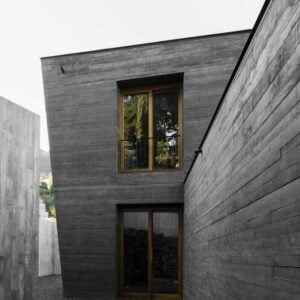Nestled along the Iberian Peninsula, where the Atlantic Ocean kisses golden shores, Portugal stands as a beacon of architectural innovation. Its cities and towns, steeped in history, are now witnessing a renaissance. A renaissance where raw concrete, with its stoic strength, meets the ethereal beauty of nature’s light, crafting homes that are both modern masterpieces and serene sanctuaries.






The Allure of Raw Concrete
Concrete, often perceived as cold and impersonal, finds a unique expression in Portuguese homes. Here, it’s celebrated for its raw beauty, its ability to capture the essence of the land. The rugged texture, the subtle variations in hue, mirror the landscapes of Portugal, from its rocky cliffs to its rolling hills.
In the hands of Portuguese architects, concrete becomes a canvas. A canvas that’s painted not with colors but with shadows and light. The walls, floors, and ceilings, crafted from this material, tell tales. Tales of the country’s rich history, its maritime adventures, its passion for exploration. Every groove, every imperfection, becomes a part of the narrative, adding depth and character to the spaces.
But beyond its aesthetic appeal, concrete offers functionality. Its insulating properties make it ideal for the Mediterranean climate, keeping homes cool in the summer and warm in the winter. Its durability ensures that these homes stand the test of time, becoming a part of Portugal’s architectural legacy.


Nature’s Light as an Architect
In Portuguese design, light is not just an element; it’s an architect. It shapes spaces, defines forms, and breathes life into structures. The country, blessed with abundant sunshine, harnesses this gift in its homes. Skylights, large windows, and open courtyards invite nature’s light in, creating interiors that are luminous and airy.
This play of light and shadow transforms concrete from a mere material to a work of art. The way the morning sun casts gentle shadows, the golden hue it imparts in the evening, the dance of moonlight on concrete surfaces, all create a spectacle, a daily performance that residents bear witness to.
Moreover, this embrace of natural light is not just about aesthetics; it’s about well-being. Spaces bathed in sunlight uplift the spirit, enhance mood, and boost productivity. They create an ambiance that’s both calming and invigorating, a perfect blend for modern living.


Melding Concrete and Light
The true magic of Portuguese design lies in the melding of concrete and light. It’s a harmonious union, where the solidity of concrete meets the fluidity of light. This synergy is evident in every nook and corner, from the way light filters through concrete screens to the patterns it creates on polished floors.
Homes designed with this philosophy become sanctuaries. They offer residents a respite from the chaos of the outside world, a place to reflect, to dream, to create. The minimalist aesthetics, devoid of unnecessary embellishments, allow the beauty of concrete and light to shine through.
This design approach also reflects Portugal’s deep-rooted respect for nature. By allowing natural light to be the primary source of illumination, these homes reduce their carbon footprint, championing sustainability. They stand as a testament to the country’s commitment to a greener, brighter future.




The Influence on Portuguese Communities
The transformation of Portuguese homes, with their raw concrete and embrace of nature’s light, has had a profound impact on communities. These structures, once symbols of modern architecture, have become gathering spots, drawing both locals and tourists. The tales of these homes, their blend of traditional materials with contemporary design, have become a source of community pride.
Local artisans, inspired by these architectural marvels, have begun to incorporate similar themes into their crafts. From pottery with concrete-like finishes to paintings capturing the dance of light and shadow, the influence is palpable. Art festivals and exhibitions, celebrating this fusion of tradition and modernity, have become regular events, drawing crowds from near and far.
For the younger generation, these homes serve as a source of inspiration. They see in them a vision of a sustainable future, a world where man-made structures coexist harmoniously with nature. Educational institutions have taken note, introducing courses that delve into the principles behind these designs, ensuring that the legacy continues.


The Global Impact of Portuguese Design
Portugal’s unique approach to design has not gone unnoticed on the global stage. Architects and designers from around the world are looking to the country for inspiration, eager to understand the philosophy behind the melding of concrete and light. International design journals and magazines regularly feature Portuguese homes, celebrating their innovation and aesthetics.
This global recognition has led to collaborations, with Portuguese architects being invited to work on projects worldwide. They bring with them their unique perspective, their deep understanding of materials, and their respect for nature. The result is a global architectural landscape that’s richer, more diverse, and more sustainable.



The Future of Design in Portugal
As Portugal continues its journey of architectural exploration, the future looks promising. Plans are already underway for community spaces, public buildings, and even entire neighborhoods that embrace the principles of raw concrete and nature’s light. The goal is to create spaces that are not just beautiful but also sustainable and in harmony with the environment.
Innovations in materials, with a focus on sustainability, are also on the horizon. Researchers are exploring ways to make concrete more eco-friendly, reducing its carbon footprint. New techniques to harness natural light, from advanced skylights to light-reflecting surfaces, are being developed, promising a brighter, greener future.

The tales of Portuguese design, with their blend of raw concrete and nature’s light, are just beginning. As the country stands at the crossroads of tradition and modernity, it chooses a path that respects the past while embracing the future. A path that promises homes that are not just structures but stories, stories that inspire, that resonate, and that will be told for generations to come.












